Educator Reviewers Share Tips and Best Practices for Virtual Learning
Learn from EdReports reviewers about how they are adapting to school closures and shifting daily learning for students online.
Related Resources
article
Tips and Best Practices for Working Remotely
Hear from EdReports staff about how they navigate a virtual work environment and stay connected to team culture and colleagues.
video
Webinar—Beyond Selection: Improving Curriculum Adoption
Discover insights from EdReports and The Decision Lab on evolving curriculum adoption to better support teachers and boost student outcomes.
news
EdReports CEO Eric Hirsch to Step Down in 2026
After a decade of transformative leadership, Hirsch will remain through June 2026 to support a seamless transition as EdReports begins its next chapter of impact and innovation.


